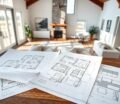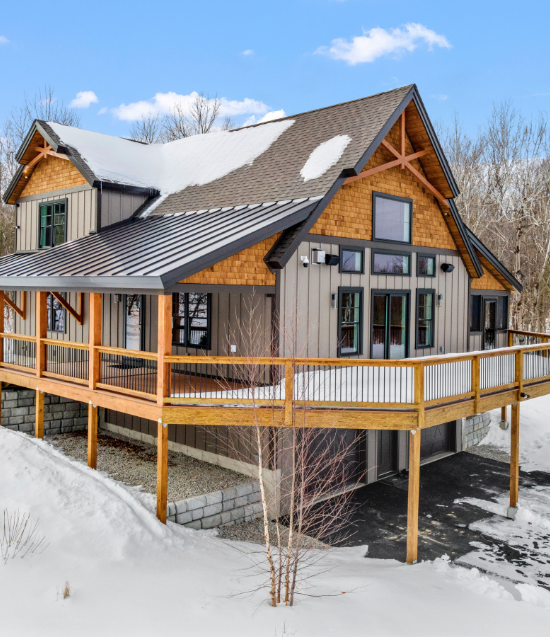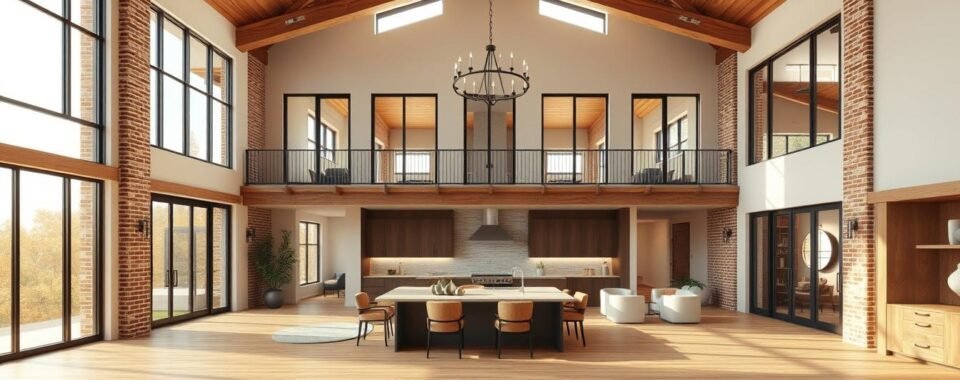

We remember our first barndominium tour vividly. It had a clear-span steel frame and sunlight-filled rooms. The contrast between the metal shell and the detailed interior was striking.
This moment made us determined. We wanted to help people choose barndo plans that are both affordable and functional. We aimed to balance structure, function, and budget for engineers, students, educators, and homeowners.
In this guide, we dive into barndominium designs and floor plans. Barndos, or shouses, use metal frames for open interiors. The shell is affordable, but finishes and size affect costs.
Expect residential areas to cost $225–$350 per sq ft. Shop areas can be $60–$80 per sq ft. We’ll cover site selection, budgeting, layout choices, and working with builders.
Our goal is to make planning easy and exciting. We want to help you make informed decisions. For more information, email us at info@barndoplans.com or call +1-844-963-9963.
Understanding Barndo Plans: What You Need to Know
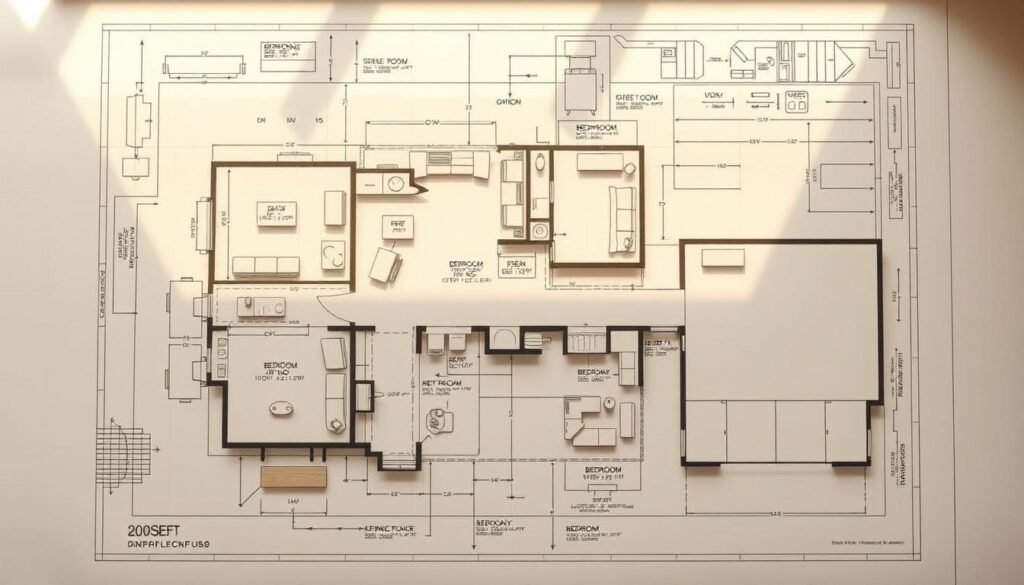
We start with the basics to give you a solid foundation. Barndo planning combines farm structures with home design. This creates a strong, adaptable home for many lifestyles. We’ll cover what barndo plans are, their benefits, and common features.
Definition of a Barndo
A barndo is a home built with metal or post-frame construction. It looks like a barn but has home features. It’s also known as a barndominium, blending barn and condominium styles.
These homes use steel or timber for their structure. Other names like shouse, pole barn home, and metal building house plans also describe this concept. They all focus on combining work and living spaces.
Benefits of Choosing a Barndo
One big plus is the open-concept design. This design lets you have big, open rooms without walls. Metal siding and roofing make building fast and easy, and they need little upkeep.
These homes are also strong against weather and pests. They’re great for people who love to tinker or run a small business. The cost can be lower than traditional homes, depending on what you add inside.
Common Features of Barndo Plans
Barndominiums often have big, rectangular shapes and high ceilings. You’ll find exposed beams, durable floors, and big garages. They also have porches and roof overhangs for outdoor space.
Modern plans include special areas for hobbies or work. They also focus on saving energy with insulation and smart features. Some even offer steel kits to make building easier for DIY fans.
Key Factors to Consider When Choosing a Barndo Plan
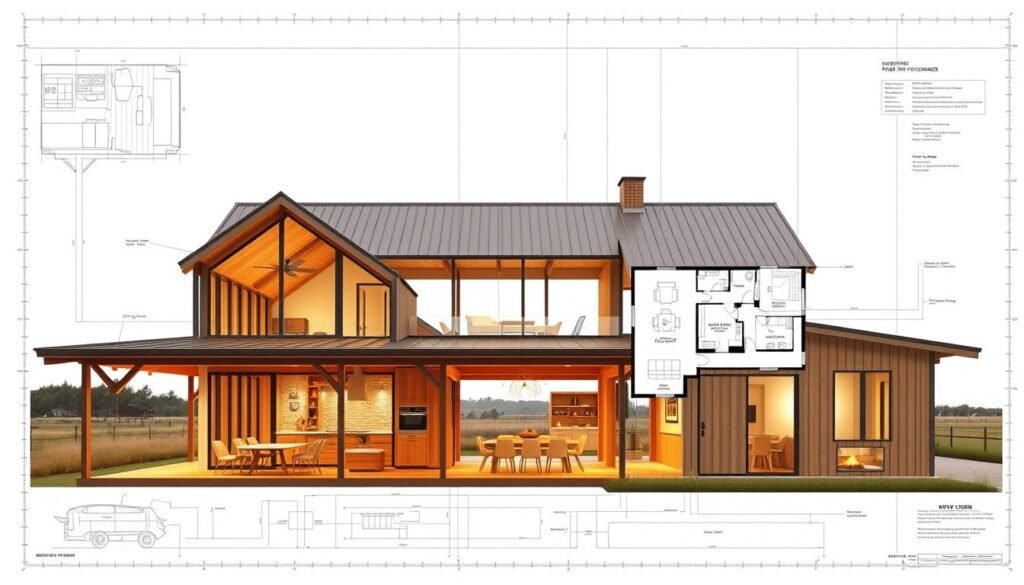
We look at both needs and wants when picking a plan. The best barndo plans mix budget, layout, and style. This way, your home works well and feels like yours.
We focus on three main areas: cost, space, and style. Each choice has its trade-offs. Think about these when looking at pole barn, steel, or barn style plans.
Budget and Costs
First, make a budget. A home section costs $225–$350 per square foot. Shop areas are cheaper, at $60–$80 per square foot. Site work can range from $1,000 to $100,000, depending on the land.
Don’t forget about utility costs. Septic systems cost $15,000–$30,000, wells $8,000–$15,000, and power service $5,000–$15,000. Gas taps are $6,000–$10,000. Permits cost $500–$3,000.
Using pre-drawn plans can save up to 90% on design fees. But, high-end finishes, big spaces, and changes can increase costs.
Size and Layout Requirements
Focus on how things flow, not just size. Keep wet areas together for easier plumbing and upkeep. For those who work a lot, put mud and laundry near the shop.
Decide between a two-story or ranch home. Two-story homes can be cheaper and offer more space. Shouse plans use most space for the shop and keep living areas small.
Check out real barndos and use 3D software to test layouts. This helps ensure the flow, views, and light are right before you commit.
Style Preferences
Choose a style that fits your climate and maintenance needs. Rustic looks like cedar and stone add warmth but cost more. Modern styles like black metal are easier to keep up but need special insulation and ventilation.
Color, cladding, and trim affect cost and durability. Pick finishes that match your climate and budget. Balance looks with practical features like insulation and windows for natural light.
When picking barn style plans, test materials and colors on your site. The right palette and finishes keep your design looking good and save on costs over time.
| Decision Area | Key Considerations | Typical Cost Range |
|---|---|---|
| Residential Finish | Flooring, cabinetry, HVAC, insulation quality | $225–$350 / sq ft |
| Shop / Garage Finish | Concrete slab, bay doors, lighting, storage | $60–$80 / sq ft |
| Site Work | Driveway, grading, erosion control | $1,000–$100,000 total |
| Utilities | Septic, well, power service, gas hookup | Septic $15k–$30k; Well $8k–$15k; Power $5k–$15k; Gas $6k–$10k |
| Design Approach | Pre-drawn plans vs custom design; expected change orders | Pre-drawn: up to 90% savings vs custom |
| Layout Strategy | Wet area clustering, mudroom placement, single vs two story | Cost impact varies by square footage and complexity |
| Style & Finishes | Cladding, trim, columns, color and maintenance needs | Variable: material choice drives long-term cost |
Exploring Different Barndo Styles
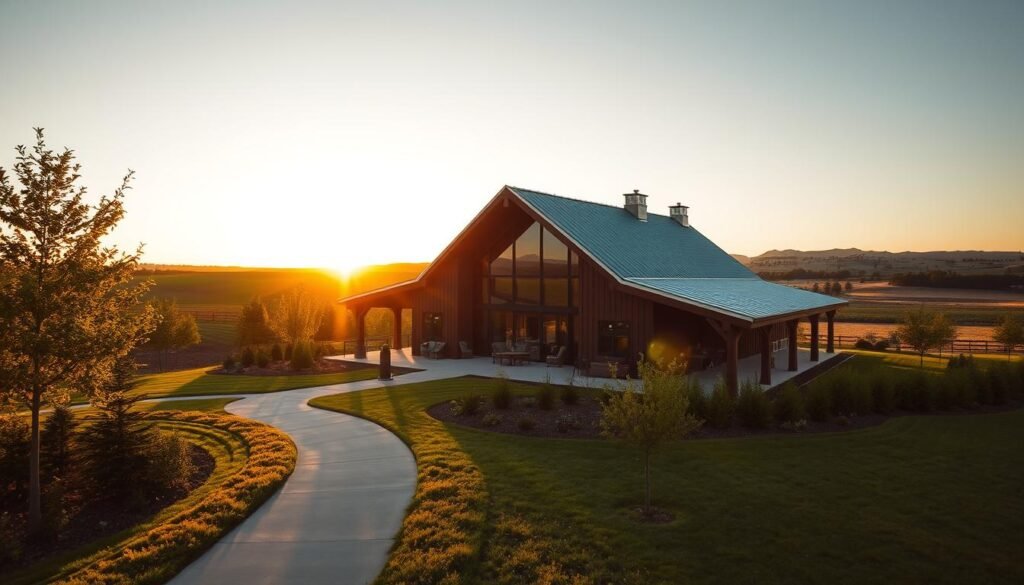
We look at three main styles for barndos. Each style combines looks, structure, and purpose. You can find rustic warmth, modern lines, and industrial looks. These styles help when picking the right barndominium design or barn style house plan.
Rustic Barndos
Rustic barndos feature wood accents and exposed timber. They have warm colors and farmhouse porches. You’ll find stone wainscoting and reclaimed materials for a cozy feel.
These homes offer traditional barn charm with modern comforts. They use wood-framed trusses or a mix of wood and steel. This supports heavy finishes and open lofts.
Great for family homes or vacation spots, rustic barndos focus on texture and warmth.
Modern Barndos
Modern barndos have clean lines and vertical metal siding. They feature large windows and open great rooms. These rooms have 16-foot ceilings and polished concrete floors.
They use steel kits for quick construction and less upkeep. Energy-saving features like spray-foam insulation and LED systems are common. Designers aim for simplicity to highlight space and light.
Industrial Barndos
Industrial barndos show off metal beams and large garage bays. They’re perfect for makers and small businesses. You’ll find concrete or epoxy floors and commercial appliances.
They use heavy-gauge steel framing and big overhead doors. Ventilation and mechanical systems are key for shop activities. These plans are great for entrepreneurs who need strong structures and flexible spaces.
For custom options, check out packages and pricing. Custom barndominium plans start at affordable prices. You can find more at custom barndominium floor plans.
Importance of Functional Spaces
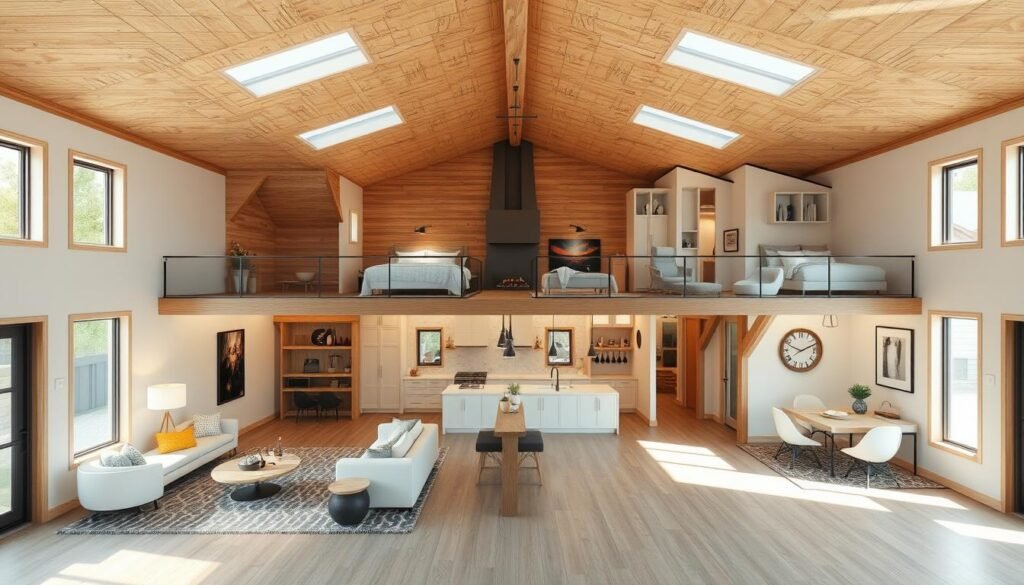
We focus on function when looking at barndominium floor plans. This makes daily life easier and building more efficient. Good planning mixes open spaces with private areas, keeps service areas close, and matches indoor and outdoor work areas.
Living Areas
Clear-span trusses let us have a great room without columns. This creates a big, open space and flexible layouts. We need to think about acoustics, HVAC, and lighting to make the room feel cozy, not empty.
Two-story designs help by separating bedrooms from living areas. This reduces the foundation size and can save on site costs. Walls, half-walls, or sliding partitions help create private areas without losing the open feel.
Kitchen Designs
The kitchen often sets the budget in barndominium designs. You can choose from simple cottage kitchens to big, professional kitchens. We suggest putting kitchens near laundry and plumbing to save on pipes and labor.
Durable materials like concrete counters, metal backsplashes, and tile floors fit well with a barndo lifestyle. Finishing early in the planning helps avoid cost surprises and keeps the project on schedule.
Outdoor Spaces
Outdoor paths are important when there are shops, lean-tos, or big storage areas. Wraparound porches and deep overhangs protect doors and make a place for muddy boots and heavy equipment.
We place outdoor areas to catch daylight and wind to improve comfort and energy use. Smart placement connects the barndo to the site, making it more functional.
Customization Options for Barndo Plans
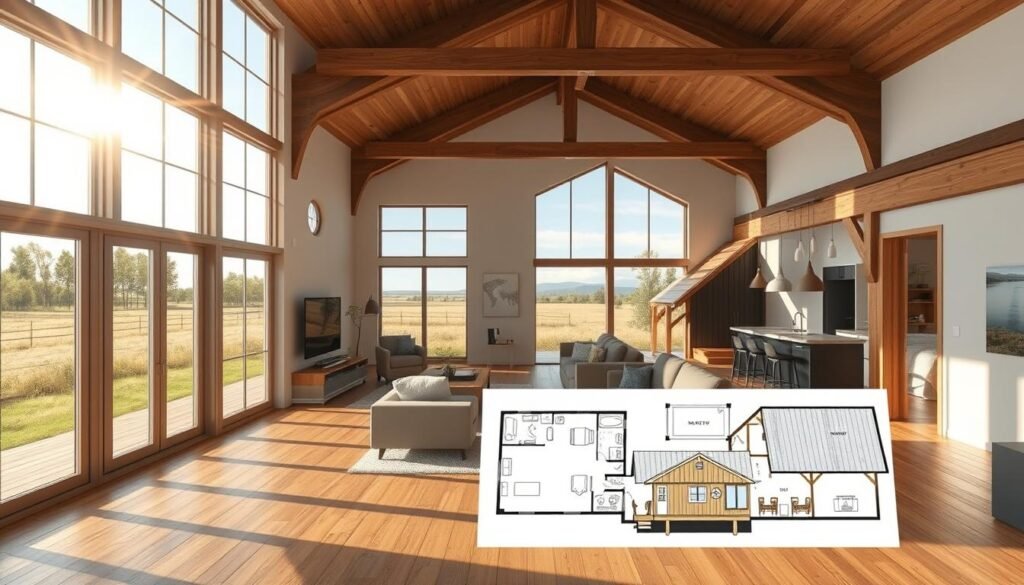
We help builders and homeowners make barndo plans their own. Small changes can save money and keep projects on time. We focus on three key areas: layout changes, performance upgrades, and finish choices.
Floor Plan Modifications
Plans from America’s Best House Plans, Architectural Designs, HousePlans, or FBi Buildings can be changed. Simple changes, like swapping room locations, can be much cheaper than custom plans.
Local codes might need engineering or stamping for these changes. It’s wise to budget for a local engineer or contractor. They can provide mechanical drawings and check for compliance with metal building house plans or steel home plans.
Energy Efficiency Upgrades
Upgrades can lower costs and improve comfort. Consider spray-foam insulation, high-performance windows, and careful air sealing. Right-sized HVAC systems are also important.
Metal shells need special attention to thermal bridging and vapor control. Adding vapor barriers, thermal breaks, and smart thermostats early can save money and prevent moisture issues.
Interior Finishes
Finish choices affect budget and timeline. Options range from durable surfaces to high-end finishes. Popular choices include polished concrete floors, resilient tile, and wood accent walls.
Cabinetry and fixtures can impact project flow. Making major finish choices early can avoid delays and change orders. This is key for smooth delivery of barndominium designs and steel home plans.
| Customization Area | Typical Options | Impact on Cost | Recommended Action |
|---|---|---|---|
| Floor Plan Modifications | Flip plans, add/remove walls, relocate garage | Low to moderate | Use pre-drawn plans; budget for local engineering |
| Energy Efficiency | Spray-foam, high-performance windows, air sealing | Moderate to high | Specify during design to avoid retrofits |
| Thermal Control for Metal Shells | Thermal breaks, vapor barriers, insulated panels | Moderate | Detail in structural drawings for metal building house plans |
| Interior Finishes | Polished concrete, tile, wood, metal accents, cabinetry | Variable — low to high | Finalize finishes before framing inspections |
| Smart & Sustainable Systems | Smart thermostats, solar-ready wiring, efficient HVAC | Moderate | Integrate early with barndominium designs |
Finding the Right Location for Your Barndo
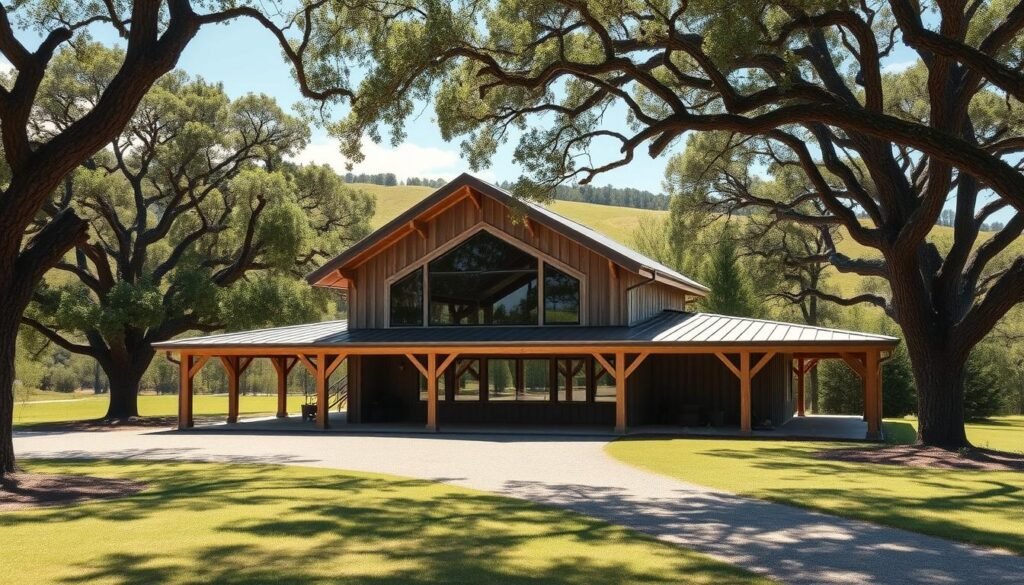
Choosing the right land for your barndo is key from the start. The size, slope, access, and utilities of the land affect your plans and the work needed. We suggest visiting the site early and doing surveys to ensure your plans fit the land and your budget.
The size and shape of the land set limits. A small or steep lot limits your options and increases costs. Tasks like clearing trees and leveling the land add to the time and money needed. We plan for these tasks before finalizing your plans.
Local rules, like zoning and building codes, also play a big role. Some areas need special drawings for certain issues. You might need to work with experts to make sure your plans meet these rules.
Zoning laws can also affect what you can build. It’s important to check these rules early to avoid changes to your plans.
Access to utilities is another big factor. If you’re close to water and sewer, connecting them is easy. But if not, you’ll need to plan for a well or septic system. These options have their own costs, which affect your plans.
Adding power or gas lines can also be expensive. Bringing in power might cost between $5,000 and $15,000. Gas line extensions can cost between $6,000 and $10,000. We work with local providers early to include these costs in your plans.
It’s important to think about how easy it will be to get to your barndo. A wide driveway and clear paths for equipment help avoid delays. Make sure access is good before you commit to your plans.
We make a checklist to manage risks and costs. This includes tests, surveys, and checking permits. This helps us match your plans to the site and give accurate budgets and timelines.
Working with a Barndo Builder
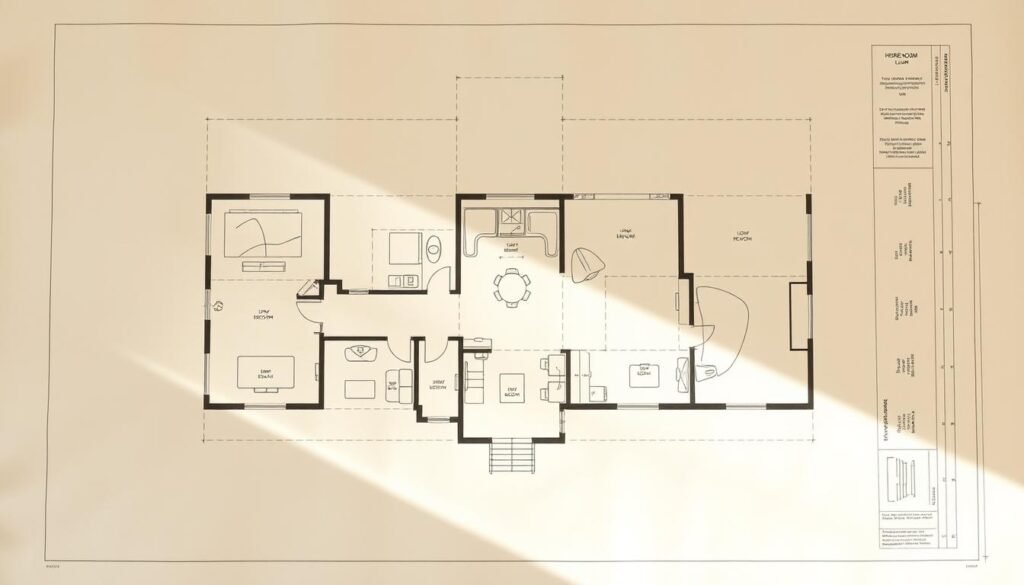
We help teams and owners find the right builder for their projects. The right choice affects the cost, schedule, and final result. This is true for barndo plans, barndominium designs, pole barn house plans, and metal building house plans.
Researching Local Builders
It’s wise to check both post-frame companies and general contractors. Post-frame builders like FBi Buildings handle the exterior shell and steel kit. General contractors focus on the interior work after the shell is locked up.
Ask for references and check their past work in your area. Make sure they are licensed, insured, and have experience with your project size. Builders familiar with your area can better handle local permits and weather issues.
Questions to Ask Your Builder
We create a list to compare different builders. Find out if they provide engineer-stamped plans or if they handle local engineering. Know what the shell includes and what the builder will do inside.
Get detailed quotes for the foundation, HVAC, plumbing, and electrical. Ask about handling changes and managing the schedule. Also, check the warranty and what documents are needed for the lender.
Reviewing Portfolios
We look at portfolios for quality and detail. Check the connections, thermal continuity, roof and wall flashing, and how the builder transitions from shop to living space. This shows the builder’s focus on long-term performance.
Choose builders with experience at your project size. Look for those who offer free 3D design tools or sample plans. This helps you see how your metal building house plans or pole barn house plans will look before you decide.
Resources for Barndo Plan Inspiration
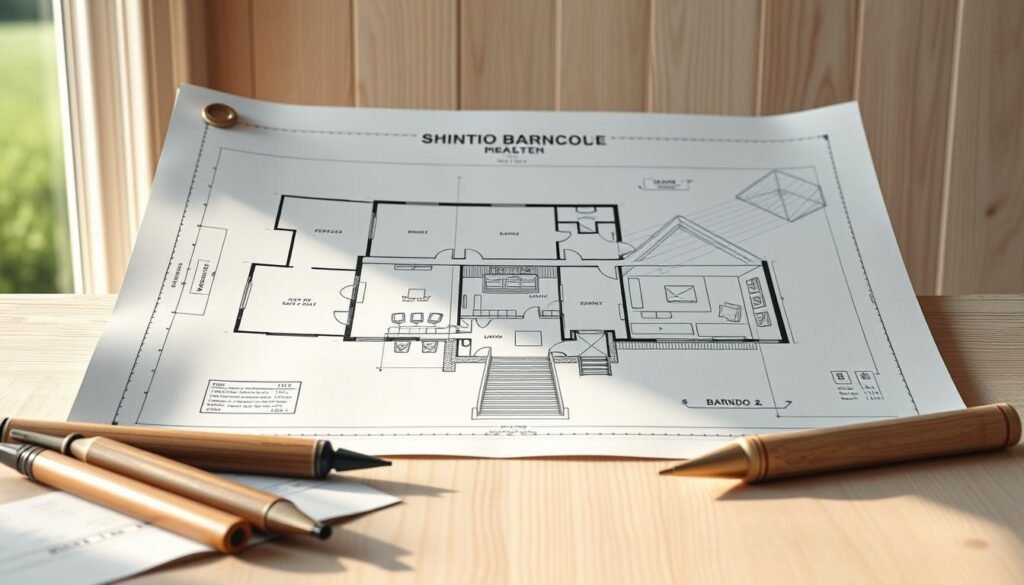
We gather practical resources to help you test ideas, validate scale, and refine finishes for barndo plans. Use digital tools to experiment with layout, color palettes, and site placement before you commit to construction.
Online Design Tools
3D configurators let us place walls, adjust ceiling heights, and preview roof types in real time. Many plan vendors provide downloadable steel kits and editable files for quick iteration.
For a broad library of pre-drawn options, explore plan providers such as America’s Best House Plans and Architectural Designs. We often reference professional libraries when comparing barndominium designs and barndo home plans to ensure technical fit.
Use Google Earth placement features to confirm driveway angles and sun exposure. That step helps validate barndominium floor plans against actual site constraints.
Social Media Platforms
Instagram and Pinterest serve as visual mood boards for finishes, trim details, and porch layouts. Search build diaries to track timelines and common site issues.
YouTube hosts project tours and technical walk-throughs from builders and owners. Watching HVAC layout videos and thermal-bridge discussions improves our understanding of real-world performance for barndo plans and barndominium designs.
Home Design Magazines
Print and digital magazines offer curated articles on materials, energy upgrades, and finish selection. They pair well with technical plan libraries when we want both style and substance.
Combine magazine inspiration with builder portfolios and the plan library at The House Designers to create an evidence-based path toward your ideal barndo home plans and barndominium floor plans.
Final Tips for Selecting Your Perfect Barndo Plan
Choosing barndo plans is both thrilling and detailed. First, make sure you’ve bought your land and have a budget. Use pre-drawn plans to save time and money. Then, customize them for your site’s needs and local building rules.
Be ready for changes and have extra money for unexpected costs. Visiting completed barndominiums is a great idea. You can see how they feel and how different areas work together.
Ask the owners about upkeep, utility bills, and the builders. This helps you see the real benefits and drawbacks that drawings can’t show. Think about what you need in a home. Do you want a place for your workshop or more living space?
Choose plans that fit your lifestyle. For example, shouse or barn style plans are good for workshops. Two-story plans offer more living space. Make sure your plans are both beautiful and practical.
Use proper HVAC, energy-saving upgrades, and durable materials. This will save you money in the long run and make your home work well. If you need help finding the right plan, contact us at info@barndoplans.com or call +1-844-963-9963. We’ll guide you to the perfect pole barn, steel, or barn style plan for your site and budget.
